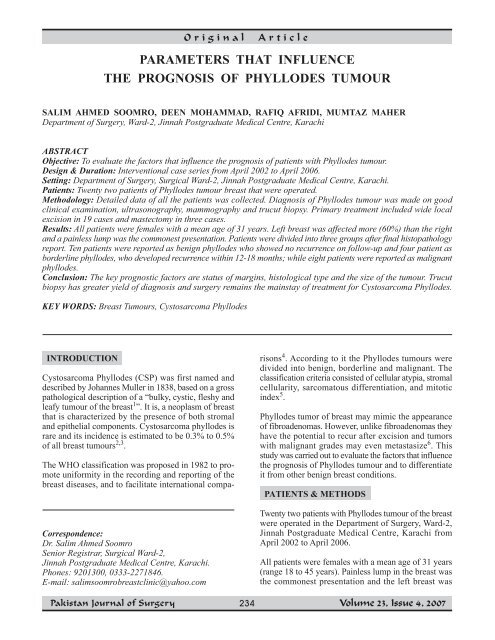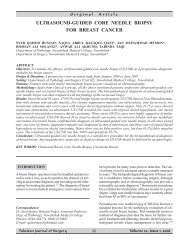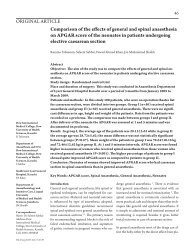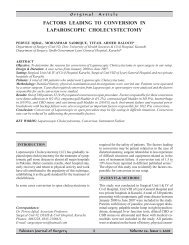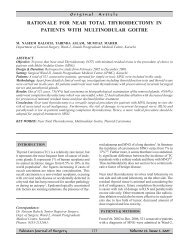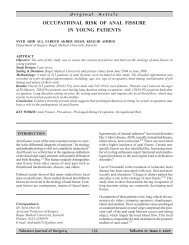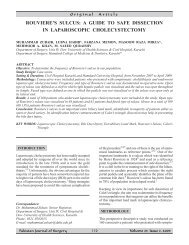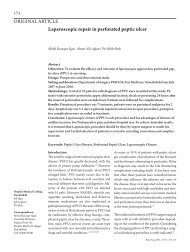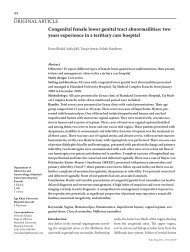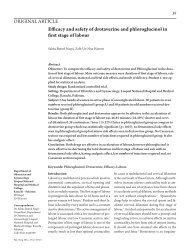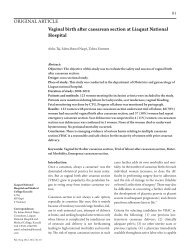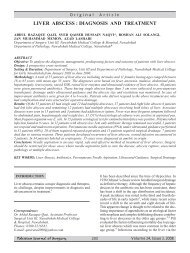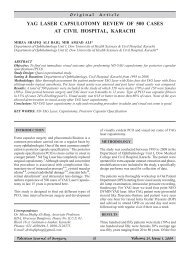Parameters that influence the prognosis of Phyllodes tumour
Parameters that influence the prognosis of Phyllodes tumour
Parameters that influence the prognosis of Phyllodes tumour
Create successful ePaper yourself
Turn your PDF publications into a flip-book with our unique Google optimized e-Paper software.
OriginalArticlePARAMETERS THAT INFLUENCETHE PROGNOSIS OF PHYLLODES TUMOURSALIM AHMED SOOMRO, DEEN MOHAMMAD, RAFIQ AFRIDI, MUMTAZ MAHERDepartment <strong>of</strong> Surgery, Ward-2, Jinnah Postgraduate Medical Centre, KarachiABSTRACTObjective: To evaluate <strong>the</strong> factors <strong>that</strong> <strong>influence</strong> <strong>the</strong> <strong>prognosis</strong> <strong>of</strong> patients with <strong>Phyllodes</strong> <strong>tumour</strong>.Design & Duration: Interventional case series from April 2002 to April 2006.Setting: Department <strong>of</strong> Surgery, Surgical Ward-2, Jinnah Postgraduate Medical Centre, Karachi.Patients: Twenty two patients <strong>of</strong> <strong>Phyllodes</strong> <strong>tumour</strong> breast <strong>that</strong> were operated.Methodology: Detailed data <strong>of</strong> all <strong>the</strong> patients was collected. Diagnosis <strong>of</strong> <strong>Phyllodes</strong> <strong>tumour</strong> was made on goodclinical examination, ultrasonography, mammography and trucut biopsy. Primary treatment included wide localexcision in 19 cases and mastectomy in three cases.Results: All patients were females with a mean age <strong>of</strong> 31 years. Left breast was affected more (60%) than <strong>the</strong> rightand a painless lump was <strong>the</strong> commonest presentation. Patients were divided into three groups after final histopathologyreport. Ten patients were reported as benign phyllodes who showed no recurrence on follow-up and four patient asborderline phyllodes, who developed recurrence within 12-18 months; while eight patients were reported as malignantphyllodes.Conclusion: The key prognostic factors are status <strong>of</strong> margins, histological type and <strong>the</strong> size <strong>of</strong> <strong>the</strong> <strong>tumour</strong>. Trucutbiopsy has greater yield <strong>of</strong> diagnosis and surgery remains <strong>the</strong> mainstay <strong>of</strong> treatment for Cystosarcoma <strong>Phyllodes</strong>.KEY WORDS: Breast Tumours, Cystosarcoma <strong>Phyllodes</strong>INTRODUCTIONCystosarcoma <strong>Phyllodes</strong> (CSP) was first named anddescribed by Johannes Muller in 1838, based on a grosspathological description <strong>of</strong> a “bulky, cystic, fleshy andleafy <strong>tumour</strong> <strong>of</strong> <strong>the</strong> breast 1 ”. It is, a neoplasm <strong>of</strong> breast<strong>that</strong> is characterized by <strong>the</strong> presence <strong>of</strong> both stromaland epi<strong>the</strong>lial components. Cystosarcoma phyllodes israre and its incidence is estimated to be 0.3% to 0.5%<strong>of</strong> all breast <strong>tumour</strong>s 2,3 .The WHO classification was proposed in 1982 to promoteuniformity in <strong>the</strong> recording and reporting <strong>of</strong> <strong>the</strong>breast diseases, and to facilitate international compa-Correspondence:Dr. Salim Ahmed SoomroSenior Registrar, Surgical Ward-2,Jinnah Postgraduate Medical Centre, Karachi.Phones: 9201300, 0333-2271846.E-mail: salimsoomrobreastclinic@yahoo.comrisons 4 . According to it <strong>the</strong> <strong>Phyllodes</strong> <strong>tumour</strong>s weredivided into benign, borderline and malignant. Theclassification criteria consisted <strong>of</strong> cellular atypia, stromalcellularity, sarcomatous differentiation, and mitoticindex 5 .<strong>Phyllodes</strong> tumor <strong>of</strong> breast may mimic <strong>the</strong> appearance<strong>of</strong> fibroadenomas. However, unlike fibroadenomas <strong>the</strong>yhave <strong>the</strong> potential to recur after excision and tumorswith malignant grades may even metastasize 6 . Thisstudy was carried out to evaluate <strong>the</strong> factors <strong>that</strong> <strong>influence</strong><strong>the</strong> <strong>prognosis</strong> <strong>of</strong> <strong>Phyllodes</strong> <strong>tumour</strong> and to differentiateit from o<strong>the</strong>r benign breast conditions.PATIENTS & METHODSTwenty two patients with <strong>Phyllodes</strong> <strong>tumour</strong> <strong>of</strong> <strong>the</strong> breastwere operated in <strong>the</strong> Department <strong>of</strong> Surgery, Ward-2,Jinnah Postgraduate Medical Centre, Karachi fromApril 2002 to April 2006.All patients were females with a mean age <strong>of</strong> 31 years(range 18 to 45 years). Painless lump in <strong>the</strong> breast was<strong>the</strong> commonest presentation and <strong>the</strong> left breast was234Volume 23, Issue 4, 2007
Prognosis <strong>of</strong> <strong>Phyllodes</strong> Tumour<strong>the</strong> optimal primary treatment is more controversial.Wide local excision was employed as <strong>the</strong> primary treatmentin <strong>the</strong> present series. When a borderline lesion recursafter primary surgery a simple mastectomy maybe required. Adjuvant radio<strong>the</strong>rapy for malignant Cystosarcoma<strong>Phyllodes</strong> have shown encouraging results 15 .CONCLUSIONThe key prognostic factors are:Status <strong>of</strong> margins: The <strong>prognosis</strong> is good if <strong>the</strong> excisionmargin are clear for >1cm.Histological type: Hypercellular stroma, high nuclearpleomorphism, high mitotic rate, infiltrating margins,presence <strong>of</strong> necrosis and increased vascularity within <strong>the</strong> <strong>tumour</strong>, carries poor <strong>prognosis</strong>.Size <strong>of</strong> tumor: A size more than 5cms, carries poor<strong>prognosis</strong>.Trucut biopsy has greater yield <strong>of</strong> diagnosis.Surgery remains <strong>the</strong> primary treatment.Strict counseling for careful long-term follow-upis recommended.REFERENCES1. Muller J. Uberden feineran bau and die formen derKrankhaften Geschwulste. Berlin: Reimer, 1838:54-60.2. Kessinger A, Foley JF, Lordon HM, Miller DM.Metastatic Cystosarcoma <strong>Phyllodes</strong>: A case report.J Surg Oncol 1972; 4: 131-47.3. Vorherr H, Vorherr UF, Kutvirt DM, Key CR. Cystosarcoma<strong>Phyllodes</strong>: Epidemiology, pathophysiology,pathobiology, diagnosis <strong>the</strong>rapy and survival. ArchGynaecol 1985; 236: 173-81.4. The World Health Organization Histological typing<strong>of</strong> Breast Tumours, 2nd edition. Am J Clin Path1982; 78: 806-16.5. Rreves N, Sunderland DA. Cystosarcoma <strong>Phyllodes</strong><strong>of</strong> <strong>the</strong> Breast: A malignant and a benign tumor. AS. A. Soomro, D. Mohammad, R. Afridi, M. Maherclinicopathologic study <strong>of</strong> 77 cases. Cancer 1951;4: 1286-1332.6. Kopans DB. Breast imaging. In: Breast Cancer, Aguide for fellows. Philadelphia, USA: J. B. LippincottCo.; 1989. p.173-74.7. Cohn-Cedermark G, Rutqvist LE, Rosendahl I, SilverswardC. Prognostic factors in Cystosarcoma<strong>Phyllodes</strong>. A clinicopathologic study <strong>of</strong> 77 patients.Cancer 1991; 68: 2017-22.8. Salvadori B, Cusumano F, Del-Bo R. Surgical treatment<strong>of</strong> <strong>Phyllodes</strong> tumors <strong>of</strong> <strong>the</strong> breast. Cancer1989; 63: 2532-6.9. Hawkins RE, Schfield JB, Fisher C. The clinicaland histologic criteria <strong>that</strong> predict metastases fromCystosarcoma <strong>Phyllodes</strong>. Cancer 1992; 69: 141-7.10. Ward RM, Evans HH. Cystosarcoma <strong>Phyllodes</strong>.A clinicopathologic study <strong>of</strong> 20 cases. Cancer 1986;68: 2286-9.11. Keish JM. Cystosarcoma <strong>Phyllodes</strong> in a 12 yearsold girl. Nigerian Cancer Med J 1974; 35: 295-6.12. McGregon GI, Knowling MA, Este FA. Sarcomaand Cystosarcoma <strong>Phyllodes</strong> tumors <strong>of</strong> <strong>the</strong> breast:A retrospective review <strong>of</strong> 58 cases. Am J Surg 1994;167: 447-80.13. Holthouse DJ, Smith PA, Naunton-Morgan R, MinchinD. Cystosarcoma <strong>Phyllodes</strong>; Western Australianexperience. Aust NZ J Surg 1999; 69: 635-8.14. Berg WA, Hruban RH, Kumar D. Lessons frommammographic – histologic correlation <strong>of</strong> largecoreneedle breast biopsy. Radiographics 1996; 16:1111-30.15. Chaney AW, Pollack A, McNeese MD, Zafar GK.Adjuvant radio<strong>the</strong>rapy for <strong>Phyllodes</strong> tumor <strong>of</strong> breast.Radiat Oncol Investig 1998; 6: 264-7.236Volume 23, Issue 4, 2007


